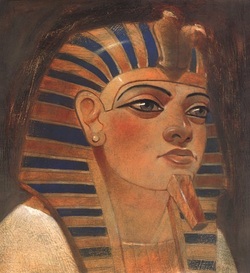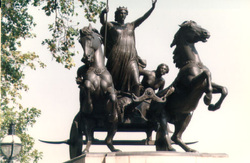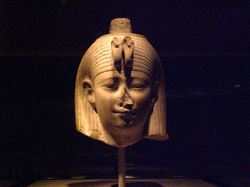Women of Power

Female-deified-Pharoah (King) Hapshetut
Many who think ancient women of power, think Nefertiti, Female-deified-Pharaoh (King)Hapshetut and Cleopatra. And although there was 7 Cleopatra's, the most popularized Egyptian female figurehead of power was the last one. Mostly known for her lasciviousness and affairs with Roman Emperor Julius Ceaser, and Roman general and tactician Marc Antony. However, there is a countless amount of powerful female figures who did not use their seductive charm to beguile men, but rather used strength and intellect to carve there way into being some of histories greats. Every corner of the world features powerful female figureheads, even in regions of the globe in which women had less sociopolicial rights than their male counterparts. Many still found ways to be productive and even thoroughly successful. Let's take a look at a few of the nominees for "women of power."
W.o.P: of Celtic Origin

Warrior-Queen of the Iceni of Norfolk, Boudicca: She participated in the Roman Revolt and led a rebellion in 61 A.D. Responsible for the pillaging of numerous Roman settlements and colonies, and used arson as a tool to lay waste to the city of Londinium (London). She was able to temporarily liberate her people from the suppressive grasp of the Roman yoke after the slaughter of 70, 000 Romanized Brits and those Roman-born. Her neck was adorned with a golden chain, she bore a spear, wore a loose gown of many colors and spread her vengeful passion over her army prior to charging into battle. History marks her as “tall of person, of a comely countenance,” and a woman of feared repute. Boudicca was no rarity however. It was common practice to the Celts that a woman should fight alongside them in battle or rule over them as the sole authoritative figure. The Roman culture was one that was thee most opposed to anti-sexist dogma and practice and were not accustomed to women in positions of power or taking on roles that in their society, were meant for reinforcing the masculinity of men. In fact, the Celts were so accustomed to women rulers that when brought before Emperor Claudius they laid themselves prostate before the throne of Empress, Agrippina the Younger, to the ever enduring chagrin of Roman society.
In 51 AD the Brigantian Queen, Castimandua, allied herself with Rome as a client state after delivering to the Romans a rebel war-lord she had captured in battle.
Other well-known Celtic warrior queens include Aife of Alba (modern day Scotland) and her contemporaries Mebd of Ireland and Scathach of Skye.
The first recorded effort to bar women from military participation was a law passed in 590 A.D. at the synod of Druim Ceat. It proved to be unenforceable when the women warriors refused to lay down their arms and comply with it.
Maude de Valerie, a Welsh revolutionary: (1100 A.D), raised an army to rebel against the oppressive regime of King John. She was captured on the battlefield and died as his prisoner.
Maire o'Ciaragain (15th Century A.D): led Irish clans against the English and was known for her ferocity in battle.
Lilliard (1545 A.D): led the Scots at the Battle of Ancrum in one of their last victories over the English forces. She killed the English commander but lost her own life later in the battle.
Graine Ni Maille (1550-1600): was an Irish princess who commanded a large fleet of war galleys which wreaked havoc on the English navy, shipping and coastal towns.
Military Commander & Tactician, Aethelflaed (870-918 A.D): Having disliked her only experience of childbirth, Aethelflaed swore herself to chastity and took the sword. She "retained a cordial friendship," with her husband, and they accompanied each other into battle until his death in 912. She continued on her own to assist Alfred the Great against the Danes., whose eldest daughter she was. Aethelflaed became the chief tactician of her time; she united fragmented Mercia and conquered Wales; she restored her nation's defenses against the Danes; and finally became de facto ruler of the Danes and Mercians. She fell in battle in June 918 at Tammorth in Statfordshire.
Her daughter, Aelfwyn, inherited the throne directly from her mother, but it was taken from her by force the following year by Aethelflaed's brother, who stepped in to become the "mightiest" English ruler of a land tamed and fortressed by a woman-allowed by the historians only an occasional footnote. Had Aethelflaed not been the daughter of Alfred the Great, we might not have any knowledge whatsoever of the greatest military commander in medieval England!
In 51 AD the Brigantian Queen, Castimandua, allied herself with Rome as a client state after delivering to the Romans a rebel war-lord she had captured in battle.
Other well-known Celtic warrior queens include Aife of Alba (modern day Scotland) and her contemporaries Mebd of Ireland and Scathach of Skye.
The first recorded effort to bar women from military participation was a law passed in 590 A.D. at the synod of Druim Ceat. It proved to be unenforceable when the women warriors refused to lay down their arms and comply with it.
Maude de Valerie, a Welsh revolutionary: (1100 A.D), raised an army to rebel against the oppressive regime of King John. She was captured on the battlefield and died as his prisoner.
Maire o'Ciaragain (15th Century A.D): led Irish clans against the English and was known for her ferocity in battle.
Lilliard (1545 A.D): led the Scots at the Battle of Ancrum in one of their last victories over the English forces. She killed the English commander but lost her own life later in the battle.
Graine Ni Maille (1550-1600): was an Irish princess who commanded a large fleet of war galleys which wreaked havoc on the English navy, shipping and coastal towns.
Military Commander & Tactician, Aethelflaed (870-918 A.D): Having disliked her only experience of childbirth, Aethelflaed swore herself to chastity and took the sword. She "retained a cordial friendship," with her husband, and they accompanied each other into battle until his death in 912. She continued on her own to assist Alfred the Great against the Danes., whose eldest daughter she was. Aethelflaed became the chief tactician of her time; she united fragmented Mercia and conquered Wales; she restored her nation's defenses against the Danes; and finally became de facto ruler of the Danes and Mercians. She fell in battle in June 918 at Tammorth in Statfordshire.
Her daughter, Aelfwyn, inherited the throne directly from her mother, but it was taken from her by force the following year by Aethelflaed's brother, who stepped in to become the "mightiest" English ruler of a land tamed and fortressed by a woman-allowed by the historians only an occasional footnote. Had Aethelflaed not been the daughter of Alfred the Great, we might not have any knowledge whatsoever of the greatest military commander in medieval England!
Arsinoe || Philadelphus

Arsinoe || Philadelphus: A Maenad, in accordance to the Greeks or a Bacchante by title of the Romans. The Maenads originate as mythological affiliates to the God of Wine and gain their entitlement as “madwomen,” for their orgiastic, sadistic rituals which resulted in the violent death of men. They were devoted worshippers of Dionysus, in
accordance to the Hellenes and Bacchus by interpretation of the Romans. Being worshippers of the effeminate God of Wine as well as madness, the priestesses celebrated the sated state instigated by alcohol in the most macabre of methods. In a drunken, drugged frenzy would they worship through acts of brutality-tearing men to pieces with the taste of wine on their tongues and hallucinogenic bay laurel numbing their minds.
The Maenads were also followers of the Horned-God Pan, who resembled depictions of Bacchus in his purest divine form. The Maenads also gave up bull or man sacrifices
to the Goddesses of Moon, Fertility and Hunt. Such as Artemis, Semele and Daphoene. Arsinoe Philadelphus the 2nd,led battles against her brother, Ptolemy || Philadelphus in 278 B.C. She married him and was recognized thereafter as the absolute authority figure in Egypt. Originally, it was Arsinoe who was granted the political power-title of Philadelphus. Later on however, this name was grafted onto her brother.
The only Ptolemaic-Egyptian Queen who wielded more power than her was Cleopatra the 7th of 69-30 B.C, whom the Romans feared, “as they feared Hannibal.” Who reigned Egypt after the death of Arsinoe. And like Cleopatra, who was believed to be the incantation of a Goddess, Arsinoe was deified during her lifetime and was renowned in Sais as Isis Arsinoe and worshipped in temples known as Arsinoeions.
Arsinoe’s name, a name common amongst Hellenic Queens of her time, translates into: “the Male-Minded.” Her Maenad roots were reflected in the agricultural sect that specialized in growing grape crops to be marketed for wine production. She introduced the Maenad/Bacchante cult to Egypt, as well as built temples in Samothrace, Sais and Thebes. Which where the focal-points of the agricultural growth of her Empire. Her income from temple taxes, tithes and wine manufacture further profited her as did her reputation as a conqueror and leader in war politics.
Her rule spread to Fayyum and she established numerous cities named in her honor at Aetolia, Crete, Cyrene, Cilicia and Cyprus, with the exclusion of those in Egypt. Legends grew around the reign of Arsinoe, legends that may have inspired several statues erected in her honors. At Athens stood the statues of many Egyptian rulers, Arsinoe being the only Queen among them.
accordance to the Hellenes and Bacchus by interpretation of the Romans. Being worshippers of the effeminate God of Wine as well as madness, the priestesses celebrated the sated state instigated by alcohol in the most macabre of methods. In a drunken, drugged frenzy would they worship through acts of brutality-tearing men to pieces with the taste of wine on their tongues and hallucinogenic bay laurel numbing their minds.
The Maenads were also followers of the Horned-God Pan, who resembled depictions of Bacchus in his purest divine form. The Maenads also gave up bull or man sacrifices
to the Goddesses of Moon, Fertility and Hunt. Such as Artemis, Semele and Daphoene. Arsinoe Philadelphus the 2nd,led battles against her brother, Ptolemy || Philadelphus in 278 B.C. She married him and was recognized thereafter as the absolute authority figure in Egypt. Originally, it was Arsinoe who was granted the political power-title of Philadelphus. Later on however, this name was grafted onto her brother.
The only Ptolemaic-Egyptian Queen who wielded more power than her was Cleopatra the 7th of 69-30 B.C, whom the Romans feared, “as they feared Hannibal.” Who reigned Egypt after the death of Arsinoe. And like Cleopatra, who was believed to be the incantation of a Goddess, Arsinoe was deified during her lifetime and was renowned in Sais as Isis Arsinoe and worshipped in temples known as Arsinoeions.
Arsinoe’s name, a name common amongst Hellenic Queens of her time, translates into: “the Male-Minded.” Her Maenad roots were reflected in the agricultural sect that specialized in growing grape crops to be marketed for wine production. She introduced the Maenad/Bacchante cult to Egypt, as well as built temples in Samothrace, Sais and Thebes. Which where the focal-points of the agricultural growth of her Empire. Her income from temple taxes, tithes and wine manufacture further profited her as did her reputation as a conqueror and leader in war politics.
Her rule spread to Fayyum and she established numerous cities named in her honor at Aetolia, Crete, Cyrene, Cilicia and Cyprus, with the exclusion of those in Egypt. Legends grew around the reign of Arsinoe, legends that may have inspired several statues erected in her honors. At Athens stood the statues of many Egyptian rulers, Arsinoe being the only Queen among them.
There is a vast and rich history of female figureheads. So much so, I couldn't cover half of them even if every page of this website was dedicated to them. These few references is for you to begin your personal journey of research. As "warrior queens," and "warrior women," are a common theme in all cultures, you should be able to find numerous sites holding tribune to them. This just being one of them.
